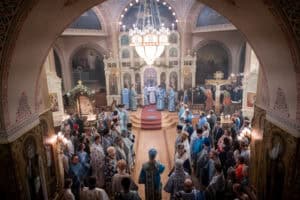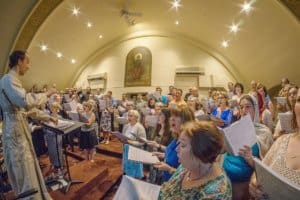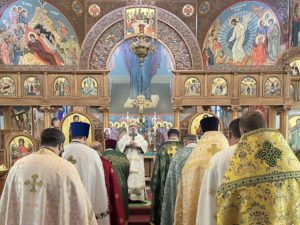PART IX
The anniversary of an important event is usually met with celebration and recognition. One of the effects of the current pandemic is that, this year, those celebrations have been mostly canceled, postponed, or drastically altered. This is undoubtedly the case for the many celebrations planned over the past two years in our deaneries, dioceses, and national Church in respect to the momentous 50th anniversary of the granting of autocephaly to the “Metropolia,” thereafter known as the Orthodox Church in America.
As many of our parishioners who this year are unable to celebrate graduations, weddings, and various other anniversaries, we faithful of the OCA feel deprived of the experience of the joyous celebrations we had been planning for some time.
Yet, there is also much that is gifted to us in this season of partial isolation and retreat. In these unusual times, we have an even greater opportunity to carefully and prayerfully acknowledge the present, to look back at the past and all that has brought us this far, and to recapture the vision that led to autocephaly.
We look back with thanksgiving for what has been accomplished in the Lord’s vineyard over the last 50 years. The work of the seminaries has been strengthened, and the seminary presses have continued to publish remarkable resources that are beneficial to both the Church and the larger community. The different departments have produced important material—especially in the field of music, education, and evangelization. Parishes have been planted in many parts of the country, and relationships with other autocephalous churches have been built. And, most importantly, priests have continued to minister to the people living in this country, striving to bring them closer to the Lord Jesus Christ through the sacramental life of the Church, ministry, and education.
The great work of hierarchs, clergy, and laity of the Orthodox Church in America over the last 50 years is built upon the sacrificial and inspiring work that led to the pivotal moment in 1970 when the Tomos of autocephaly was received by the hands of Metropolitan Pimen of the Russian Orthodox Church. Among many, the vision and efforts of Archbishop John (Shahovskoy), Archbishop Kiprian, Archbishop Sylvester, Fr. George Benigsen, and Fr. John Meyendorff must be acknowledged and always recognized. In particular, we remember the visionary, sacrificial, and courageous work of Fr. Alexander Schmemann whose tenacity and determination were critical in the process leading to the agreement with the Russian Orthodox Church. This recalls, for instance, what Metropolitan Theodosius writes in an article published on the 25th anniversary of the autocephaly (The Orthodox Church, Vol: 31:6/7). His Beatitude recounts that at a meeting in the phase preceding the formal agreement on autocephaly, Metropolitan Nikodim of Leningrad “offered to begin negotiations concerning potential autonomy for the Metropolia. Fr. Alexander, whose role was pivotal in articulating the vision of our autocephaly, firmly replied, ‘No, we are beyond that.’” The only path deemed possible was one that would lead to autocephaly.
Looking back would remain, however, an abstract exercise on our part if we failed to consider how this informs our present situation and the way forward. After 50 years of autocephaly, how do we see the Orthodox Church in America?
In the preface to his Of What Life Do We Speak?, His Beatitude, Metropolitan Tikhon, speaks of the Church in North America as sprouting “first as a tender shoot, then as a frail sapling, and finally as the young tree that it is today.” As he notes immediately after, “This young tree is still tender and in need of nurturing and strengthening.” This provides a sound and sensitive overview on our current situation. In such a description, we are offered a humble, and yet realistic, perspective, devoid of delusional triumphalism in which we sometimes tumble.
I would offer, though, that this image does not exclusively apply to the OCA, but rather to the Church in North America as a whole in its various jurisdictional manifestations. Looking back to our initial roots at the time of the first missionaries in 1794, the Church still finds herself “not yet the mustard tree which is greater than all other herbs and shoots out great branches so that the birds of the air may lodge under its shadow,” to quote His Beatitude Tikhon again.
The outlook on the entire Church in North America—beyond its jurisdictional boundaries, so to say—is not simply an area of interest for the OCA. “Uniting all Orthodox Christians of America into one Church,” as Metropolitan Theodosius points out in the same article referenced earlier, is one of the principle tasks of the Orthodox Church in America. That critical vision continues to be carried on today by His Beatitude, Metropolitan Tikhon, who writes in Of What Life Do We Speak?, that “Our Synod is prepared to undertake steps to incarnate our humble, servant role in promoting the unity of the Church in America” (Pillar Three).
It is beyond the scope of this short reflection to consider the numerous pastoral and evangelistic benefits of administrative unity, and it is equally beyond the same scope to offer even general observations on the various aspects of such a process. It suffices to say that many different and complex factors both facilitate and hinder this process.
Yet, in faithfulness to the emphasis placed on the role of the OCA in the pursuit of administrative unity in North America, there is a clear call for both clergy and faithful of the Church not to stand by—disenchanted, perhaps, by the slow progress in the process of unity at other levels— but to proactively play the critical role to which all members of the Church have been called.
To this very point, Metropolitan Tikhon calls our attention to the broad responsibility in the mission of the Church, indicating that, “What is called for is a Church-wide endeavor, involving every parish, institution, and individual of the Orthodox Church in America.”
One of the most tangible areas in which each clergy and faithful can contribute is the inter-parish relationship, ministry, and worship at the local level. Across the US, we find a number of examples where important work is made with inter-jurisdictional participation. To that end, clergy brotherhoods and associations play a leading role in promoting an experience of the Church beyond the jurisdictional divisions.
I note here how Cleveland, Ohio—through the Greater Cleveland Council of Orthodox Clergy which has promoted cooperation among parishes and parishioners for many decades—can serve as a model for other metropolitan areas in the country that are still lacking that interjurisdictional experience. Ministries, such as St. Herman’s House FOCUS, ZOE for Life!, St. Mary of Egypt Ministry, and St. Panteleimon Outreach, offer opportunities to experience the Church beyond jurisdictional divisions.
In light of that foundational task of the OCA’s autocephaly, clergy and faithful alike of the Orthodox Church in America, must continue to participate and play a leading role in any efforts that promote unity. This can only be done while adopting that Christo-centric approach that His Beatitude envisions when he refers to the members of the Holy Synod, that is one where each of us “incarnate our humble, servant role in promoting the unity of the Church in America.”
The 50th anniversary of autocephaly charges us with a clear task: to look back at what stood at the foundation of the vision which was carried on with sacrificial love and determination. That vision that moved many hearts and minds and that has borne much fruit over the last five decades. There is a tremendous need to make that vision alive and present at all levels of the Church and to strengthen the pillars around which the mission of the Church is articulated in His Beatitude Tikhon’s document. The tender shoot that sprouted in Alaska is called to become a mustard tree with strong and great branches where all people of this blessed land may find nurture and refuge.





